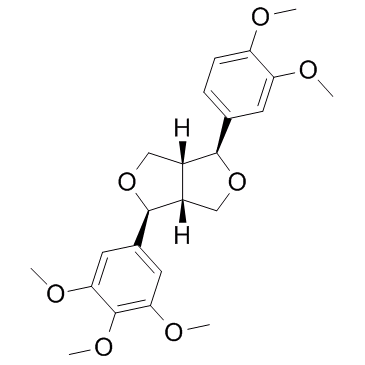Magnolin (Synonyms: (+)-Magnolin) |
| Katalog-Nr.GC31735 |
Magnolin, ein Hauptbestandteil von Magnolia flos (Shin-Yi), hemmt die Ras/ERKs/RSK2-Signalisierungsachse, indem es auf die aktive Tasche von ERK1 und ERK2 mit IC50-Werten von 87 nM bzw. 16,5 nM abzielt.
Products are for research use only. Not for human use. We do not sell to patients.

Cas No.: 31008-18-1
Sample solution is provided at 25 µL, 10mM.
Magnolin, a major component of Magnolia flos (Shin-Yi), inhibits the Ras/ERKs/RSK2 signaling axis by targeting the active pocket of ERK1 and ERK2 with IC50s of 87 nM and 16.5 nM, respectively.
Magnolin is a natural compound abundantly found in Magnolia flos, which has been traditionally used in oriental medicine to treat headaches, nasal congestion and anti-inflammatory reactions. Magnolin targets the active pockets of ERK1 and ERK2, which are important signaling molecules in cancer cell metastasis. Magnolin inhibits NF-κB transactivation activity by suppressing the ERKs/RSK2 signaling pathway. Magnolin inhibits the production of tumor necrosis factor-α (TNF-α) and prostaglandin E2 (PGE2) by inhibiting extracellular signal-regulated kinases (ERKs), which are key signaling molecules in the regulation of cell proliferation, transformation and cancer cell metastasis. JB6 Cl41 cell migration enhanced by EGF treatment is dramatically suppressed by Magnolin treatment in a dose-dependent manner. Magnolin inhibits ERK1/2/RSK2 signaling-mediated IκBα phosphorylation at Ser32, resulting in the inhibition of NF-κB activation and cell migration[1].
[1]. Lee CJ, et al. Magnolin inhibits cell migration and invasion by targeting the ERKs/RSK2 signaling pathway. BMC Cancer. 2015 Aug 8;15:576.
|
Cell experiment: |
JB6 Cl41 (7×104), A549 (7×104) and NCI-H1975 (7×104) cells, and RSK2+/+ (7×104) and RSK2-/- (7×104) MEFs are seeded into culture-inserts and cultured overnight. The cells are treated with mitomycin-C (10 μg/mL) for 2 h, and the culture-inserts are removed to offer a cell-free gap. The cells are treated with the indicated doses of Magnolin (15, 30, and 60 μM) either in the presence or absence of EGF for 12 or 24 h, and cell migration is observed under a light microscope. The migrated area is measured using the Image J computer software program. To measure the Magnolin effect on cancer cell invasion, a matrigel-coated invasion chamber is used. Briefly, A549 or NCI-H1975 (2.5×104) cells are seeded into an insert chamber with FBS-free media supplemented with the indicated doses of Magnolin(15, 30, and 60 μM), and cultured in 24-well plates supplemented with complete media for the appropriate time period. The cells are fixed with 4 % formaldehyde, permeabilized with methanol and stained with crystal violet. The stained cells are observed under a light microscope and those that have migrated are counted[1]. |
|
References: [1]. Lee CJ, et al. Magnolin inhibits cell migration and invasion by targeting the ERKs/RSK2 signaling pathway. BMC Cancer. 2015 Aug 8;15:576. |
|
| Cas No. | 31008-18-1 | SDF | |
| Überlieferungen | (+)-Magnolin | ||
| Canonical SMILES | COC1=C(OC)C(OC)=CC([C@H]2OC[C@]3([H])[C@@H](C4=CC=C(OC)C(OC)=C4)OC[C@@]32[H])=C1 | ||
| Formula | C23H28O7 | M.Wt | 416.46 |
| Löslichkeit | DMSO : 125 mg/mL (300.15 mM) | Storage | Store at -20°C |
| General tips | Please select the appropriate solvent to prepare the stock solution according to the
solubility of the product in different solvents; once the solution is prepared, please store it in
separate packages to avoid product failure caused by repeated freezing and thawing.Storage method
and period of the stock solution: When stored at -80°C, please use it within 6 months; when stored
at -20°C, please use it within 1 month. To increase solubility, heat the tube to 37°C and then oscillate in an ultrasonic bath for some time. |
||
| Shipping Condition | Evaluation sample solution: shipped with blue ice. All other sizes available: with RT, or with Blue Ice upon request. | ||
| Prepare stock solution | |||

|
1 mg | 5 mg | 10 mg |
| 1 mM | 2.4012 mL | 12.006 mL | 24.0119 mL |
| 5 mM | 0.4802 mL | 2.4012 mL | 4.8024 mL |
| 10 mM | 0.2401 mL | 1.2006 mL | 2.4012 mL |
Step 1: Enter information below (Recommended: An additional animal making an allowance for loss during the experiment)
 g
g
 μL
μL

Step 2: Enter the in vivo formulation (This is only the calculator, not formulation. Please contact us first if there is no in vivo formulation at the solubility Section.)
Calculation results:
Working concentration: mg/ml;
Method for preparing DMSO master liquid: mg drug pre-dissolved in μL DMSO ( Master liquid concentration mg/mL, Please contact us first if the concentration exceeds the DMSO solubility of the batch of drug. )
Method for preparing in vivo formulation: Take μL DMSO master liquid, next addμL PEG300, mix and clarify, next addμL Tween 80, mix and clarify, next add μL ddH2O, mix and clarify.
Method for preparing in vivo formulation: Take μL DMSO master liquid, next add μL Corn oil, mix and clarify.
Note: 1. Please make sure the liquid is clear before adding the next solvent.
2. Be sure to add the solvent(s) in order. You must ensure that the solution obtained, in the previous addition, is a clear solution before proceeding to add the next solvent. Physical methods such as vortex, ultrasound or hot water bath can be used to aid dissolving.
3. All of the above co-solvents are available for purchase on the GlpBio website.
Quality Control & SDS
- View current batch:
- Purity: >98.50%
- COA (Certificate Of Analysis)
- SDS (Safety Data Sheet)
- Datasheet
Average Rating: 5 (Based on Reviews and 19 reference(s) in Google Scholar.)
GLPBIO products are for RESEARCH USE ONLY. Please make sure your review or question is research based.
Required fields are marked with *



















